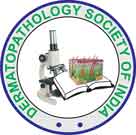Answer to Image of the Month February 2013
Submitted by Sonu Nigam
Kaposi sarcoma
This is a skin biopsy from a 3mm macule on the foot of an 88-year-old man. The histology showed a nodular lesion in the dermis comprised of intersecting fascicles of spindled cells. There were slit-like spaces present with extravasated red blood cells. A few hyaline globules and focal haemosiderin deposition was noted. Interspersed lymphocytes and plasma cells were present. The features were consistent with Kaposi sarcoma (KS).
Kaposi sarcoma is an intermediate-grade (borderline) tumour of blood vessels usually seen in AIDS patients. It is related to human herpesvirus-8 (HHV-8) or KS-associated herpes virus (KSHV). There are four forms of the disease:
1. Chronic KS (Syn Classic KS or European KS): seen in older Eastern European or Mediterranean men, not associated with HIV infection
2. Lymphadenopathic KS (Syn African or Endemic KS): Aggressive form, not associated with HIV infection
3. Transplant-associated KS: Very aggressive form
4. AIDS-associated (epidemic) KS
There are three stages recognised: patch, plaque and nodule. Initially the classic KS, when localised, can be treated by excision. Radiotherapy and chemotherapy are used to treat disseminated disease. For HIV-associated KS, antiretroviral therapy is useful. Newer treatments include interferon-alpha, angiogenesis inhibitor and other targeted therapies.
